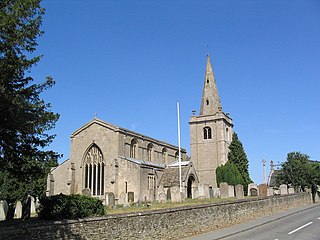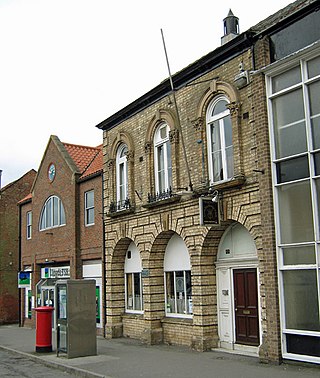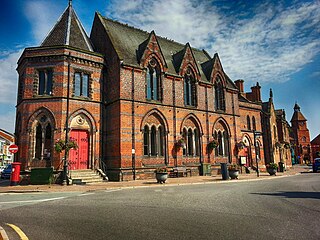
Bourne is a market town and civil parish in the South Kesteven district of Lincolnshire, England. It lies on the eastern slopes of the limestone Kesteven Uplands and the western edge of the Fens, 11 miles (18 km) north-east of Stamford, 12 miles (19 km) west of Spalding and 17 miles (27 km) north of Peterborough. The population at the 2011 census was 14,456. A 2019 estimate put it at 16,780.

The Corn Exchange is an events and concert venue located on St Paul's Square in the Castle area of Bedford, Bedfordshire, England. The structure, which was commissioned as a corn exchange, is a Grade II listed building.

Witham on the Hill is a village and civil parish in the South Kesteven district of Lincolnshire, England. The population of the civil parish was 260 at the 2011 census.

Toft is a small village in the South Kesteven district of Lincolnshire, England. It is situated approximately 2 miles (3 km) south-west from Bourne on the A6121. Toft is part of the civil parish of Toft with Lound and Manthorpe. The population of the civil parish at the 2011 census was 333.

The Palace Theatre & Grand Hall Complex is a multi-purpose entertainment arena complex in Green Street, Kilmarnock, Scotland. The structure, which was originally opened as a corn exchange, is a Category A listed building.

Charles Bell FRIBA (1846–99) was a British architect who designed buildings in the United Kingdom, including over 60 Wesleyan Methodist chapels.

Corn exchanges are distinct buildings which were originally created as a venue for corn merchants to meet and arrange pricing with farmers for the sale of wheat, barley, and other corn crops. The word "corn" in British English denotes all cereal grains, such as wheat and barley. With the repeal of the Corn Laws in 1846, a large number of corn exchanges were built in England, particularly in the corn-growing areas of Eastern England.

Bourne Town Hall is a municipal building in North Street, Bourne, Lincolnshire, England. The town hall, which was the headquarters of Bourne Urban District Council, is a Grade II listed building.

The Corn Exchange is a commercial building in the St Catherine Street, Cupar, Fife, Scotland. The structure, which is now used as a community events venue, is a Category B listed building.

The Corn Exchange is a commercial building in Gloucester Street in Faringdon, Oxfordshire, England. The structure, which is currently used as a community events venue, is a Grade II listed building.

The Corn Exchange is a commercial building in Conduit Street, Lichfield, Staffordshire, England. The structure, which is used as a series of shops on the ground floor and as a restaurant on the first floor, is a Grade II listed building.

The Corn Exchange is a commercial building in Queen Street, Market Rasen, Lincolnshire, England. The structure, which is used as the offices of a firm of charted surveyors, is a Grade II listed building.

Westgate Hall is a commercial building in Westgate, Grantham, Lincolnshire, England. The structure, which was last used as a nightclub, is a Grade II listed building.

The Corn Exchange is a commercial building in Sandgate, Berwick-upon-Tweed, Northumberland, England. The structure, which is now used as an apartment block, is a Grade II listed building.

The Corn Exchange is a commercial building in Broad Street, Stamford, Lincolnshire, England. The structure was refurbished between 2001 and 2008 and is now used as a theatre.

The Corn Exchange is a commercial building in Sincil Street, Lincoln, Lincolnshire, England. The structure, which is now used as a restaurant and shops, is a Grade II listed building.

The Corn Exchange is a commercial building in the Market Place in Barton-upon-Humber, Lincolnshire, England. The structure, which is now used as a private members club, is a Grade II listed building.

The Corn Exchange is a commercial building in the Market Place in Alford, Lincolnshire, England. The structure, which is currently used as a community events venue, is a Grade II listed building.

The Sandbach Literary Institute, also known as Sandbach Literary Institution, is a commercial building in Hightown in Sandbach, Cheshire, England. The structure, which is currently used as a community events venue, is a Grade II listed building.

Long Sutton Market House, also known as Long Sutton Market House and Corn Exchange, is a commercial building in Market Street in Long Sutton, Lincolnshire, England. The structure, which is now used as a community events venue, is a locally listed building.






















